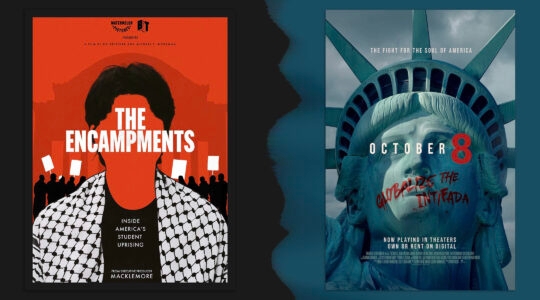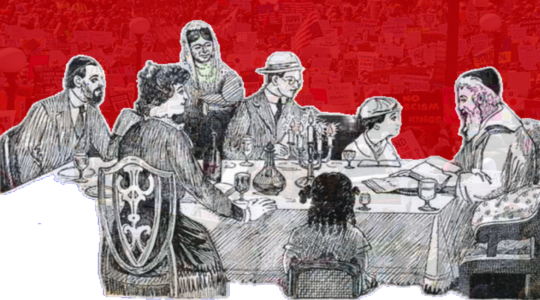The other main Capitol Hill sport these days (after obsessive coverage of the Petraeus scandal) is how the government can avoid the impending Fiscal Cliff. A similarly serious financial challenge lurks in the future of the Jewish Community – namely, how how do we better balance our books and continue to fund and maintain an engaging, vibrant and thriving Jewish community worldwide? We may not be running toward a cliff, but a slide to the bottom of the hill leaves you in the same place.
Unfortunately, to solve the Jewish Fiscal Crisis (“JFC”) , we do not have a Congressional Budget Office to analyze the data or the ability to convene an umbrella committee to formulate and execute a coordinated strategy. The Jewish problem is more systemic and fragmented and cannot be solved by fiat of raising taxes or cutting programs. The JFC will only be resolved through addressing difficult structural issues and thoughtfully addressing how:
1. We are organized
2. We educate and motivate donors and collect monies, and
3. We deliver services through a complex structure of separate yet (ideally) non-duplicative organizations
As a long-time participant and funder in Jewish life with a good sense of our history and complicated communal psyche, I appreciate how truly fortunate we are relative to previous generations. The point of this commentary is not: “Woe is us.” Nor am I simply satisfying an innate need to kvetch or show how much I know or point fingers at what has gone wrong.
Rather, the focus here is to present ideas and generate a discussion that leads to collaboration. These ideas are all rooted in my practical experience as a business strategist and nonprofit activist and a genuine concern that our community needs to develop strategies that:
A) Increase overall communal resources for worthwhile initiatives, and
B) Generate and allocate our communal resources in the most efficient manner possible
Background: Impending Jewish Fiscal Crisis Explained
The Jewish community has always contended with some level of financial strain, but the situation has materially deteriorated due to numerous interrelated factors and trends, including:
Difficult macroeconomic times, which have increased demand for poverty services and annual subsidies (e.g. for synagogue membership and day school tuition)
Generational shift in funders, with groups like Avi Chai spending down and next generation mega-donors frequently focused on non-Jewish causes
Limited growth to no growth in Federation ongoing campaigns (not including emergency disaster and crisis relief)
Continued inefficiencies as organizations duplicate services yet refuse to merge or coordinate
Expanded reliance on “free” pricing practices (Birthright, PJ Library, Chabad, High Holidays, etc.) spawning a communal entitlement psychology
Inability to effectively leverage new technologies to materially lower operating and marketing cost structures
Increased un-affiliation as individuals have weaker formal ties to religious organizations
Lack of unity with certain funders and segments (e.g. ultra-orthodox) with targeted giving on particular agenda and not broader needs
Approach: Working from Reality to Vision
To approach these issues it is helpful to start with a McKinsey-style “strategy meditation” in which we visualize our communal potential and examine how actual Jewish life stacks up to this vision. This is the modeh ani of the process – it awakens us to reflect on what is working, what needs improvement and what steps we can take to reach our potential.
This discussion framework is not meant to be critical and destructive but rather to assess what is working as well as what needs to be done to better satisfy our community’s current and future needs.
Vision: Preserving our Foundation while Seeking Innovation
To create the necessary economic foundation for the Nextgen Jewish community, we need a game-changing cooperative approach that disrupts the current economic paradigm while at the same time takes into account established organizations such as the Federation network, and keeps intact the UJA’s important role in the community, especially in times of emergency (Israel, disaster relief, etc.) and as safety net for individuals and organizations.
So how do we move forward? The publishing industry serves as an instructive model in this regard. Publishers are investing heavily in innovation in the new world of ebooks and online distribution while at the same time working to protect their core print, brick-and-mortar businesses. Significant restructuring and mergers in the field are just one visible manifestation of this dynamic process.
We should apply this separate-but-focused approach in the Jewish Community. The Federation system and the large incumbent organization are our printed books and we need to ensure their continuing, valuable, bottom-line contribution. At the same time – in a way that does not jeopardize major components of the Jewish enterprise – we need to explore and master innovative “ebook” approaches.
Plan: Alternative Strategy Group with Focused Initiatives
The truth is that we will only achieve substantive improvement through a collaborative effort that leads to a select number of focused initiatives that ultimately disrupt and improve how the market system operates. A number of alternative strategies have already been discussed but never materialized or were implemented unsuccessfully due to poor timing, insufficient funding or lack of community buy-in. The best example of this is the 1950 McIver Report, which made recommendations on how to create a more efficient communal enterprise. The recommendations were not embraced and it is an instructive example of how difficult it is to affect change with a top-down approach, especially when entrenched organizations are involved.
Thus the challenge is not just to envision and implement any one option, but also to achieve widespread community acceptance. With this goal in mind, we should empower an out-of-the-box, Simpson-Bowles style committee to brainstorm, create and help implement such game-changing initiatives.
The participants would need to include key funders and leaders in incumbent organizations with leadership by visionary participants inside the community – forward-thinking federations (Combined Jewish Philanthropies of Boston), philanthropic groups (Charles and Andrea Bronfman, Avi Chai or Schusterman Foundations), philanthropic resources (Jewish Funders Network) – and market-savvy outsiders (Steve Einhorn or Jeff Weiner of Linkedin).
The critical ideas on the agenda for this group are not necessarily high profile, exciting projects, but rather the spinach on the table. They may not be as fun to eat, but they will give the community the basic nutrients to increase resources across the board and allow donors to more efficiently allocate for our future.
Here are four ideas this committee should consider:
Idea 1: A Transparent Marketplace
In 2008, I completed the first Jewish GDP Study to analyze the Jewish “nonprofit economy” and understand where resources are directed. (The final study is available online and included in the Appendix.) This tedious exercise made me acutely aware that funders have limited information when it comes to the operating procedures and financials of individual organizations as well as the state of Jewish philanthropy as a whole and how organizations fit within it. The situation is even hazier for many Israeli based NGO’s. Our community needs to better collect and organize this critical, baseline information on financials, best practices and strategies/missions.
An organized effort to create a centralized database could serve as an invaluable digital resource for organizations and funders. Information is power and we need to make our donors smarter about their choices and allocations. Donors can’t maximize their efficiency if they can’t assess where the dollars are going and how they are being spent.
As part of an open and accessible marketplace, we need to create incentives for organizations to participate. There is a chicken-and-egg problem here since organizations will not be willing to take the time and effort to disclose this information if there is no perceived benefit, and donors won’t use the resource if only a few organizations are participating. (This is the “network effect” challenge of starting a business that brings people together – such as a dating or social media website. On the other hand, successfully becoming the “it” network leads to huge opportunities as more and more people join and the entire project builds momentum.)
The failing with past initiatives of this sort was that there has not been a critical mass of donors and organizations coming together to make this all worthwhile. To overcome this hurdle, we would initially focus on select categories (e.g. Israel advocacy, day school education in a geographic area, etc.) to achieve a targeted critical mass.
We would also need to explore how to properly introduce a “Seal of Approval” or “Transparency Hekscher” that has clout with donors and is thus sought after by organizations. In particular religious organizations, which currently have no public filing requirements, need to be convinced to participate. At this time there is no public information for the many religious organizations including mega-orgs like the Orthodox Union and Chabad.
Idea 2: Empowered and Informed Donors
A one-size-gives-all mentality no longer works in our increasingly fragmented community where a growing segment of individuals are less focused on institutional fulfillment and more interested in individual giving based on personal interests. A federated or slightly modified federated model should continue to flourish and can handle that trend in part, but we need to expand other donor engagement and networking models that embrace and empower donor choice and flexibility. This effort should build off existing efforts including the Jewish Funder’s Network and funder/advisor activity from advisors such as Joseph Hyman.
What is called for is a charity information platform that educates, activates and connects the Jewish community and is a trusted source that provides independent, high-quality and conveniently accessible information. This is not just a standalone website but will be a larger initiative that includes online and offline elements all designed to improve donor engagement.
This can be achieved by collating existing information as well as collecting additional materials to help funders be better informed and thereby more effective market participants. In sum, the program should:
1. Offer access to organizations and initiatives in need of funding
2. Aggregate relevant market and economic data (in conjunction with Idea 1 above)
3. Provide insight into understanding investment opportunities
4. Serve many market segments (global, national, local or focus area)
5. Help networks to collaborate (including grant challenges)
6. Develop a metric system for evaluating social return on investment
7. Empower personal giving
Idea 3: Communal Efficiency
Also at issues is how to best serve the needs of the Jewish community irrespective of funding levels. There is a long history to the question that probably dates back to Moses, but one of the best way to think about the problem is to re-read in detail the 1950’s McIver Report (which I already mentioned once above). The McIver Report, with its comments about duplication and lack of real coordination among organizations, could have easily been published today:
“Throughout the whole area of inter-agency relationships we are concerned with the lack of teamwork, the unwillingness or the inability of agencies to pull together for the sake of common objectives.
End the sheer duplication of services – by sheer duplication we mean the performance separately by two or more agencies of a service that could be provided by one alone without a double staff and without limiting its range or, broadly speaking, its efficacy.
Assure interconsultation and some degree of common planning in areas of overlapping activities.
Stop the failure of the four Washington, D.C., offices to meet and confer on the policy decisions to which they are all committed is a case in point.
The problem with any commissioned study on Jewish communal life is that while it is not too hard to find problems, it is extremely difficult to implement solutions that overcome these problems. With McIver, there was no way to build consensus for any of the proposed changes concerning consolidation/cooperation and the recommendations were abandoned. This inability to implement sweeping efficiencies persists today with organizations stubbornly uninterested in any formal mergers or sharing of operations except in desparate, near-bankruptcy situations.
At the recent GA in Baltimore, there was a session on “poster mergers” in New Jersey and Orange County, Calif. More resources need to be devoted to helping organizations start joint-venture operations and merge where it makes sense. There should be a venture fund with access to experienced professionals to assist organizations with the leap to consolidation.
As part of the Jewish GDP work, it was clear there are many organizations working in similar areas that might benefit from a range of coordination and cooperation. An outgrowth of improving the transparency and organization of philanthropic information in a way that empowers donors (Ideas 1 and 2) is that philanthropists in a space (e.g. Israel Advocacy) might seek to entice organizations to coordinate and possibly merge. For example, I tried unsuccessfully to generate merger interest in the Jewish media industry. Ultimately, to make this work there needs to be education, clear benefits, capital to fund transitions and open-mindedness in terms of future staffing and roles and responsibilities.
Idea 4: Jewish Giving Category Campaign
Last but not least we need to address how to increase the overall amount of money given to Jewish causes. The goal is for the Jewish Community to can gain a larger share of the donor’s philanthropic wallet. Many organizations do a fabulous job of engaging donors but on an aggregate basis our numbers are down and the percent given jewishly has gone down. This is a fundamental problem.
Part of this can be addressed on individual basis by better matching donors with the right causes/styles of giving and facilitating an engaging and seamless philanthropic experience (all of which are primary goals of the ideas listed above). In addition, though, we need to educate and inform our extended community about why it is important to give Jewishly. This would be general campaign to generate awareness on the importance of Jewish giving and engage funders to increase their allocation to Jewish charities by addressing attitudes, the paradox of choice and informational requirements.
Think of this as a Got Milk? campaign for the Jewish community. In our case the focus needs to center on Jewish pride and Jewish values with a general campaign and then targeted outreach based on an individual’s profile including percent given to Jewish causes, age and charity interests.
An important element of this campaign is differentiating between “giving universal” and “giving particular.” For any universal issue, such as Hurricane Sandy or an international crisis, we need to explain why it makes sense to give to the UJA or WJS as opposed to a secular organization solving the same problem. For particular Jewish community causes it comes down to showing the compelling and essential nature of the need.
At the JPPI conference, there were several discussions on how we need an organized outreach to the new generation of Jewish multi-millionaires who have chosen not to support Jewish causes. Designing the right product and message would be one mission of this Jewish “category campaign.”
In the end, though, we need to keep in mind that the category campaign is ultimately just an awareness tool. We will not win over major sources of new money through a campaign, but rather through a thoughtful and organized approach to giving Jewishly. This will only be accomplished through the types of initiatives discussed in this paper and other ideas that arise through these discussions.
The point is not to create the next Birthright, Natan or PJ Library, but to lay the groundwork for future disruptive and transformative ideas to get the resources they need to flourish. It may be “one step removed” from these high-profile, exciting ideas, but it is no less vital.
Mark Pearlman is a business and marketing strategist in New York.
Note: This paper is an outgrowth of my previous study (“Creating a Jewish GDP,” The Jewish Week, April 2008) and my recent participation in the 2012 JPPI conference, which included sessions on the ways and means of the community.
The New York Jewish Week brings you the stories behind the headlines, keeping you connected to Jewish life in New York. Help sustain the reporting you trust by donating today.




